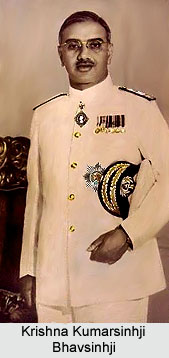 Krishna Kumarsinhji Bhavsinhji was the last ruling Indian prince, who held the title of Maharaja, of the Indian princely state of Bhavnagar during the rule of the British Empire in India. He reigned over the territory from the year 1919 to 1948. He was also an Indian politician who served as the first Indian Governor of Madras (now Chennai) from the year 1948 to 1952. Maharaja Krishna Kumarsinhji Bhavsinhji of Bhavnagar was born on 19 May 1912 at Bhavnagar, as the heir and eldest son of Maharaja Bhavsinhji II of Bhavnagar, whoc reigned over the state from 1896 to 1919. After the death of his father in the year 1919, Krishna Kumarsinhji succeeded Maharaja Bhavsinhji II and ascended the royal throne of Bhavnagar state. As he was still a minor at the age of seven years during his succession to the throne, the Krishna Kumarsinhji Bhavsinhji ruled under regency till he reached the age of majority in the year 1931.
Krishna Kumarsinhji Bhavsinhji was the last ruling Indian prince, who held the title of Maharaja, of the Indian princely state of Bhavnagar during the rule of the British Empire in India. He reigned over the territory from the year 1919 to 1948. He was also an Indian politician who served as the first Indian Governor of Madras (now Chennai) from the year 1948 to 1952. Maharaja Krishna Kumarsinhji Bhavsinhji of Bhavnagar was born on 19 May 1912 at Bhavnagar, as the heir and eldest son of Maharaja Bhavsinhji II of Bhavnagar, whoc reigned over the state from 1896 to 1919. After the death of his father in the year 1919, Krishna Kumarsinhji succeeded Maharaja Bhavsinhji II and ascended the royal throne of Bhavnagar state. As he was still a minor at the age of seven years during his succession to the throne, the Krishna Kumarsinhji Bhavsinhji ruled under regency till he reached the age of majority in the year 1931.
Rule of Krishna Kumarsinhji Bhavsinhji
After Maharaja Krishna Kumarsinhji Bhavsinhji of Bhavnagar state was invested with full ruling powers, he took charge of the administrative functions of the state. The new Maharaja continued the development and progressive reforms of the previous ruler, Maharaja Bhavsinhji II. He also focused on improving the method of tax collection in the princely state of Bhavnagar. Krishna Kumarsinhji introduced village councils and the first legislature, the Dharasabha, in the princely state of Bhavnagar. Due to his progressive rule, Krishna Kumarsinhji Bhavsinhji, the Maharaja of Bhavnagar, was knighted with the Knight Commander of the Order of the Star of India (KCSI) by the British Empire in India in the year 1938. But he clandestinely remained focus to the cause of national independence.
After the withdrawal of the British Government and the Indian independence in 1947, Maharaja Krishna Kumarsinhji Bhavsinhji became one of the first Indian rulers to accede to the newly formed Union of India. The princely state of Bhavnagar was merged into the state of Kathiawad in the year 1948.
Krishna Kumarsinhji was appointed as the Rajpramukh of United State of Kathiawar in 1948. H became the first Indian Governor of Madras, who served till 1952. He was also made an honorary Commodore in the Royal Indian Navy in the same year. Furthermore, the former ruler served as the President of the Shree Nandkunverba Kshatriya Kanya Vidhyalaya and as Vice-Patron of the United Service Institution of India from 1948 to 1952.
Personal Life of Krishna Kumarsinhji Bhavsinhji
Krishna Kumarsinhji Bhavsinhji was married to Maharani Shri Vijaya Bakunverba Sahiba in 1931. She was the daughter of Maharaja Bhojirajsinhji of Gondal. The royal couple had three daughters and two sons, namely Maharajkumari Maharaj Kumari Ba Shri Hansa Kunverba Sahiba, Maharajkumari Ba Shri Dilhar Kunverba Sahiba, Maharajkumari Ba Shri Rohini Devi Sahiba, Maharajkumar Shivbhadrasinhji Krishna Kumarsinhji and Virbhadrasinhji Krishna Kumarsinhji.
Maharaja Krishna Kumarsinhji Bhavsinhji of Bhavnagar state died at the age of 52 on 2nd April 1965, after a rule of 46 years. He was succeeded by Virbhadrasinhji Krishna Kumarsinhji, his eldest son, who ascended the throne as the Maharaja of Bhavnagar.
Titles of Krishna Kumarsinhji Bhavsinhji
Krishna Kumarsinhji Bhavsinhji, Maharaja of the princely state of Bhavnagar held several titles through out his reign. These are mentioned below-
* Maharajkumar Shri Krishna Kumarsinhji Bhavsinhji Sahib Gohil, Yuvraj Sahib of Bhavnagar (1912- 1919)
* His Highness Maharaja Raol Shri Krishna Kumarsinhji Bhavsinhji Sahib, Maharaja of Bhavnagar (1919- 1937)
* Lieutenant His Highness Maharaja Raol Shri Krishna Kumarsinhji Bhavsinhji Sahib, Maharaja of Bhavnagar (1937- 1938)
* Lieutenant His Highness Maharaja Raol Shri Sir Krishna Kumarsinhji Bhavsinhji Sahib, Maharaja of Bhavnagar, KCSI (1938- 1943)
* Captain His Highness Maharaja Raol Shri Sir Krishna Kumarsinhji Bhavsinhji Sahib, Maharaja of Bhavnagar, KCSI (1943- 1945)
* Lieutenant Colonel His Highness Maharaja Raol Shri Sir Krishna Kumarsinhji Bhavsinhji Sahib, Maharaja of Bhavnagar, KCSI (1945- 1946)
* Colonel His Highness Maharaja Raol Shri Sir Krishna Kumarsinhji Bhavsinhji Sahib, Maharaja of Bhavnagar, KCSI (1946- 1948)
* Commodore His Highness Maharaja Raol Shri Sir Krishna Kumarsinhji Bhavsinhji Sahib, Maharaja of Bhavnagar, KCSI (1948- 1965)
* Commodore His Excellency Shri Sir Krishna Kumarsinhji Bhavsinhji Gohil, Governor of Madras State, KCSI (1948- 1952)
Honours of Krishna Kumarsinhji Bhavsinhji
Maharaja Krishna Kumarsinhji Bhavsinhji was honoured a number of times, which are stated as follows-
* King George V Silver Jubilee Medal (1935)
* King George VI Coronation Medal (1937)
* Knight Commander of the Order of the Star of India- KCSI (1938)
* War Medal (1945)
* Defence Medal (1945)
* India Service Medal (1945)
* Indian Independence Medal (1947)



















